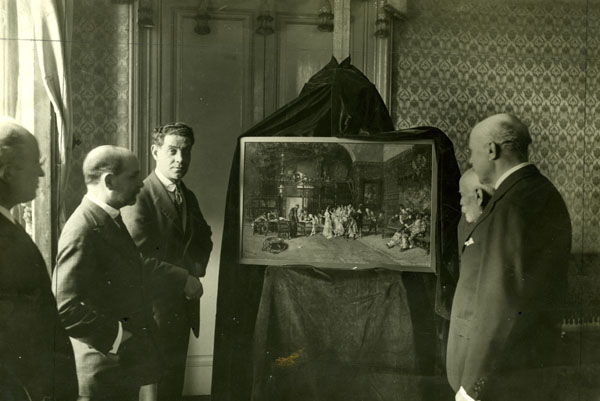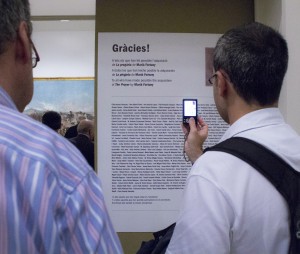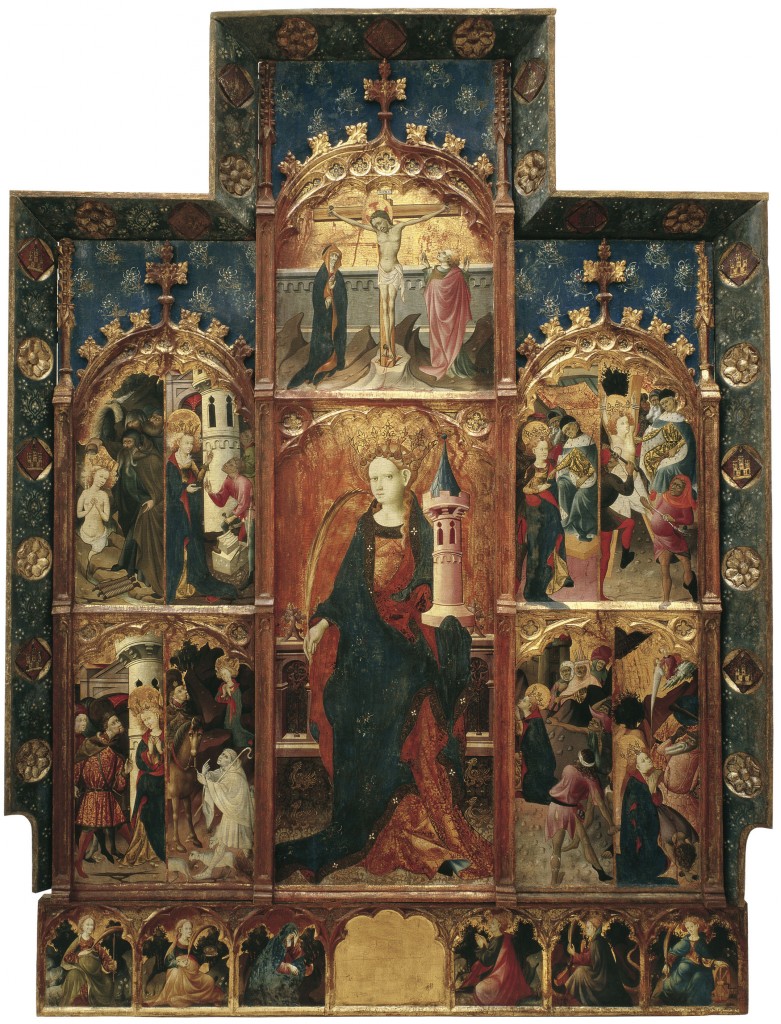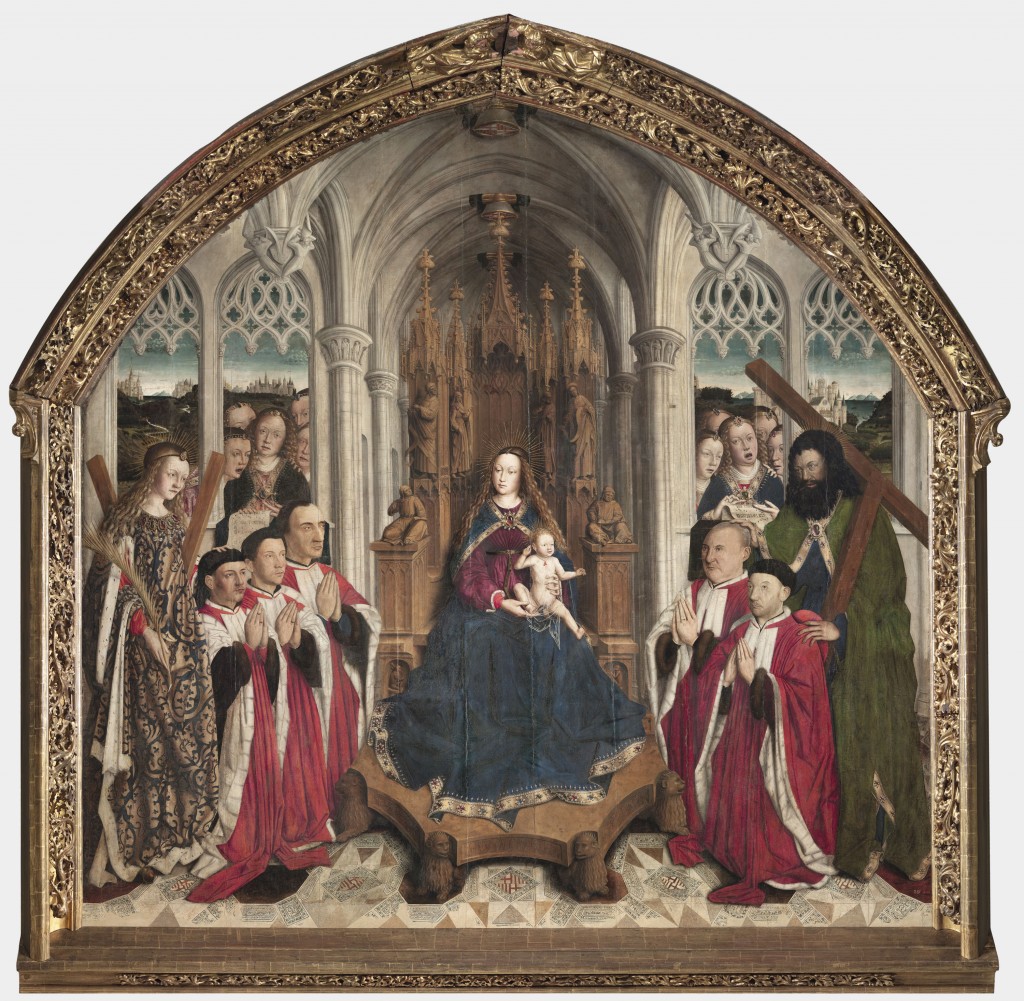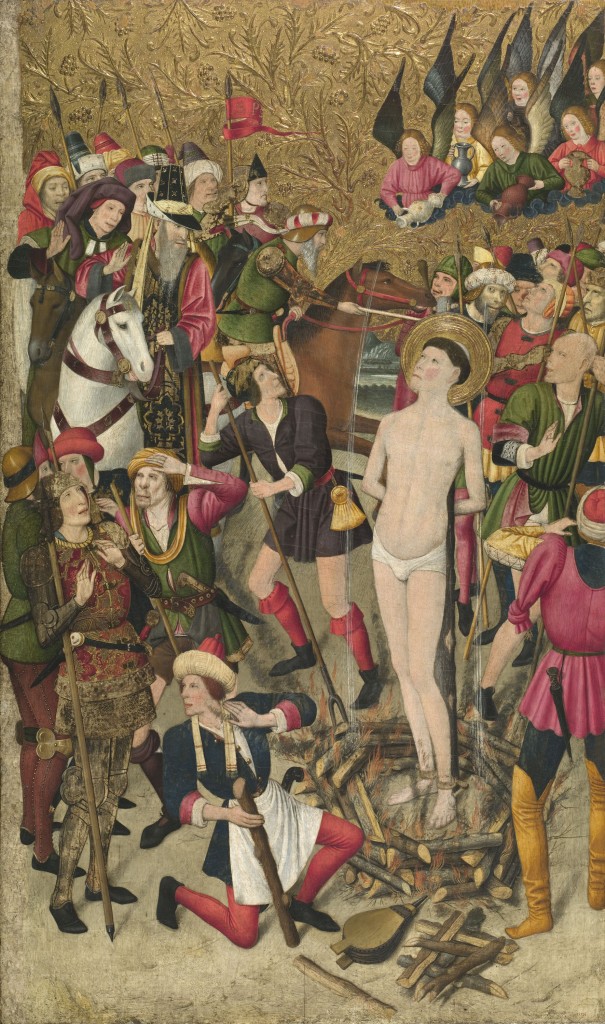Artur Ramon
Whenever I accompany a foreign friend to the Museu Nacional I try to follow a chronological path in order to help him or her to grasp the magnitude of the collections in an orderly manner. I start with the Romanesque Art section and its “Sistine Chapel”, the misnamed Pantocrator by the Master of Taüll. A Pantocrator is the half-body image of God the Father, as depicted by Cimabue and appearing in the Byzantine Arthurian mosaics in the cathedral of Monreale. The Christ of Taüll is in fact a Maiestas Domini, as it shows Christ in majesty inside a mandorla or mystic almond. The power of this image is imposing, the eyes of Christ who, seated on the throne, sees all and judges all.
Let us consider the poor twelfth-century wretch who saw as many images in his whole lifetime as we do in one hour, and stood completely rooted to the spot before that magnificent image. A medieval Big Brother, a monstrously large eye that sees everything and watches over us, as in George Orwell’s novel Nineteen Eighty-four. If we turned it to the right – we can do this today thanks to image processing – we would obtain an enormous eye, a representation not far removed from Magritte’s eye. Indeed, in Romanesque mural painting the idea of the eye is present in both senses: conceptual and formal, abstract and concrete. The eye is the almond shape of the mandorla, but it is also multiplied in the wings of the animals that symbolize the prophets in Taüll and of the cherubs in the apse of Santa Maria in Àneu.
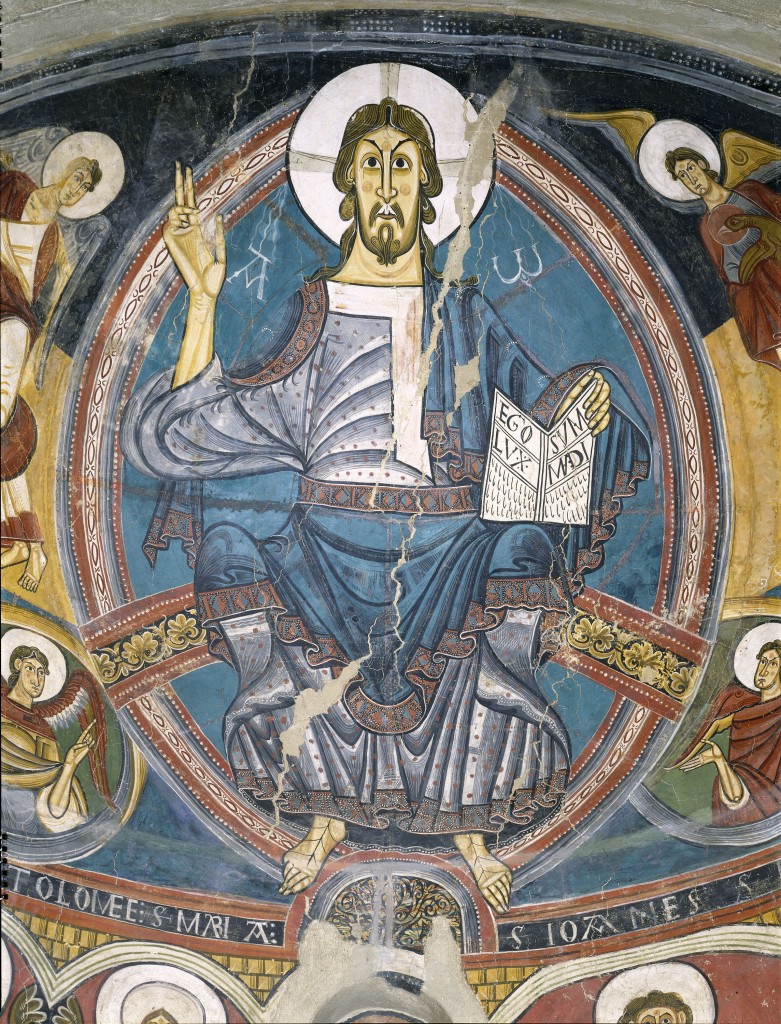
Apse of Sant Climent de Taüll, Master of Taüll, circa 1123
It is an exercise in pure lines and primary colours, a reflection on symmetry with details taken from the natural world – the fisherman’s sandals that Christ wears – or from the imagination, winged monsters with multiple eyes. It is no surprise that the artists of the avant-garde, who went to the museum like someone who goes to market to buy food, liked this repertoire of images from a remote world so much; later they would cook them slowly in their ateliers. Through Taüll we understand some works by Picabia; and without the iconic resonance of the mural paintings in the Boí valley, Picasso would never have been able to construct Les Demoiselles d’Avignon, the work that changed the course of twentieth-century painting.
Ego sum lux mundi (“I am the light of the world”) says the legend in the book that Christ is holding in his hands and showing us. At the dawn of medieval art the text supports the image. The same inscription appears on the book held by the boy sitting in the lap-chair of his mother in one of the most beautiful Marian woodcarvings in the museum: the Virgin of Ger. I notice her fish-shaped eyes, the fabric of her cloak, still with echoes of early Christian reliefs, and the small cushion on which she sits. We can also sense that which we cannot see: the two silver-coloured crowns that covered the heads of the Mother and the Child. Human covetousness removed them, leaving the heads unprotected and ridiculous, as though wearing the headbands that tennis players use to gather up their hair. It is the Maiestas Mariae, a type of cult still present today in our sanctuaries, from Montserrat to Núria.
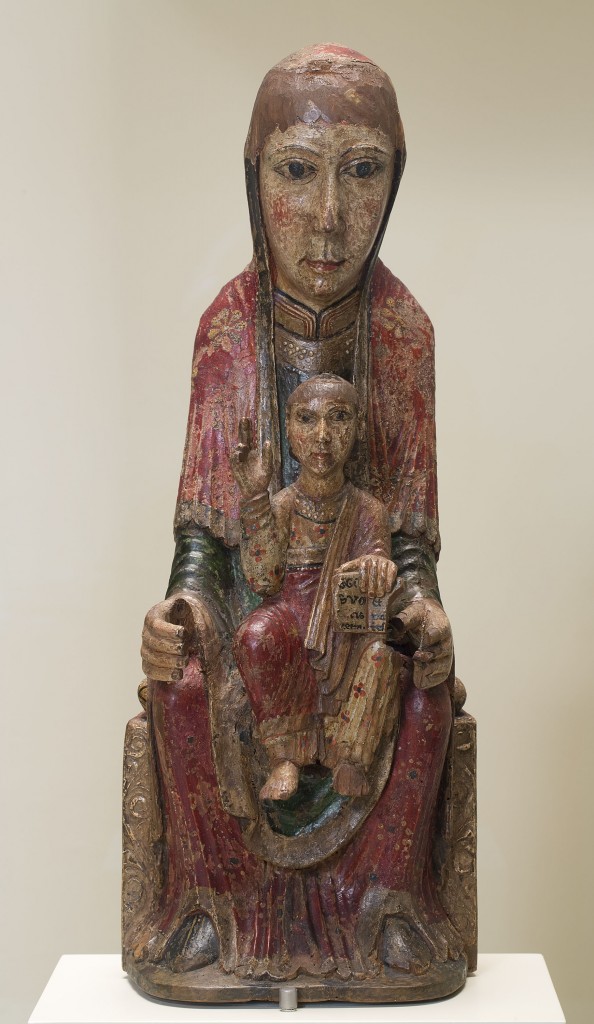
Virgin from Ger, Anonymous, Second half of 12th century
The Batlló Majesty is one of the supreme works of medieval sculpture. I cannot take my eyes off its kind face and the hair, so well treated, symmetrical, perfect, the colours of the clothes, the belt that marks the prominent stomach … The beard is a prodigy of technical virtuosity, and the border of the cross has Muslim echoes. There is nothing dark or dramatic in this image, which contrasts with the later crucifixions that fuse the athletic anatomy of the male body with the pathos of a man abandoned by his father, God. Not here. The cross is not the instrument of martyrdom but the throne upon which this good man rests. And he does not look at God asking him why he has abandoned him; his entranced gaze wanders here and there in and beyond time.
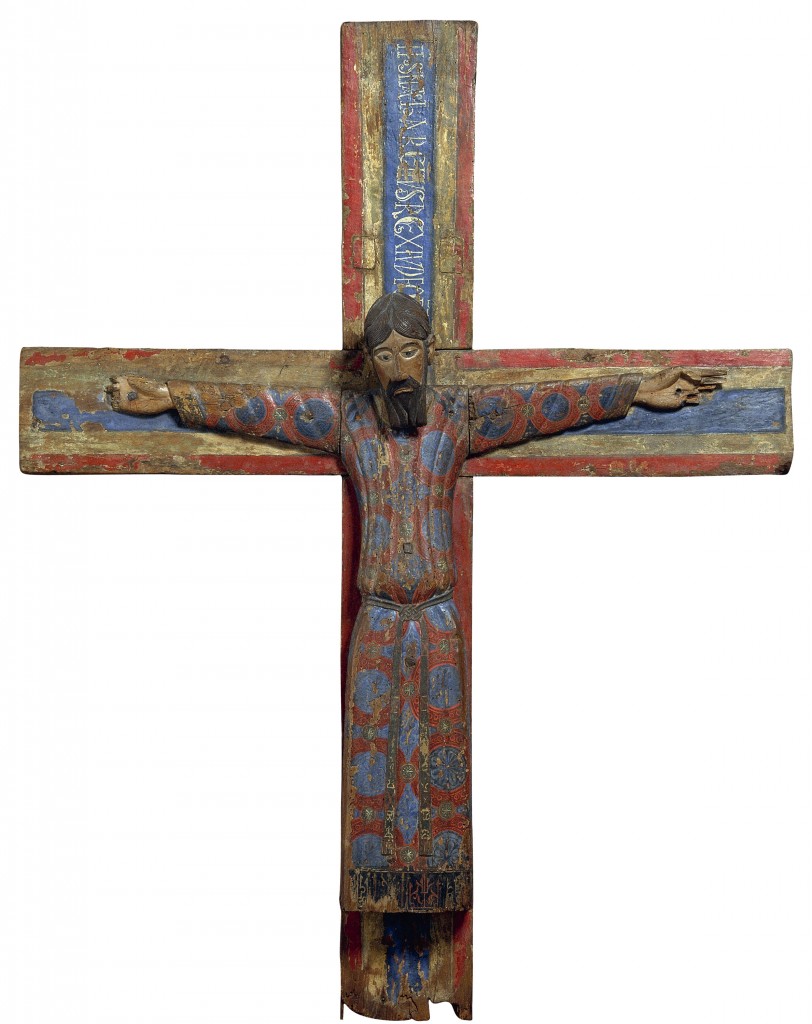
Batlló Majesty, Anonymous, Mid-12th century
I walk around the museum’s Romanesque rooms and I notice extraordinary details. I realize that altar frontals are the embryos of retables, on which an image and four scenes appear, a visual synthesis that gets through to the faithful very clearly. I also see that in Romanesque paintings the saints never touch the holy scriptures with their hands and they protect them with a piece of cloth.
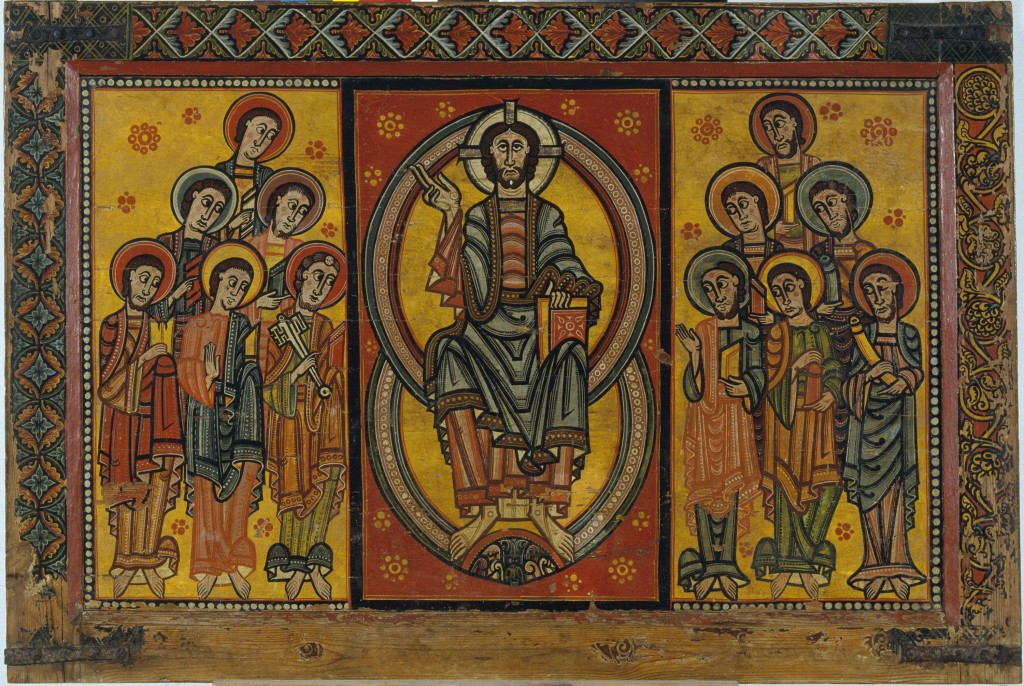
Altar frontal from La Seu d’Urgell or of the Apostles, La Seu d’Urgell workshop, Second quarter of 12th century
I have always been surprised by the imbalance between the collections housed in the Museu Nacional d’Art de Catalunya and the scant repercussions it has among us. I know many people who have only ever been there on school outings long ago, and when a foreign friend visits us we always think of other museums bearing the name of the “holy trinity” of modern art – Picasso-Miró-Dalí – before taking them to the MNAC. There are several reasons for this, and possibly they all centre on the fact that we have turned our museum into a cliché, that is, an argument that by being repeated so much has become a commonplace. We must break down the cliché and prejudice, the psychological barriers that prevent us from enjoying the finest collection of medieval art in the world, notable in the Renaissance and the Baroque and excellent in modern art.
The connecting thread of our museum, the script, is the very history of Catalan art, but from the death of Jaume Huguet (1492) to the birth of Modernisme (1890) there is a 400 year void. Our best seventeenth-century painter, Antoni Viladomat, would not enjoy an outstanding place in the finest centres of production of his day, Madrid and Seville, where masters of the stature of Velázquez, Cano, Zurbarán and Murillo worked – artists by whom the Museu Nacional has a few works, thanks to the purchase of much of the Gil Babot Collection in 1942.
The works in our museum were not stolen from anywhere, nor do they come from royal collections. The museum itself was the result of two wishes. The first was to protect the heritage, and this prompted the Museums Board to save the Romanesque mural paintings in the early twentieth century. Without this intervention, we would have to go to any large American city in order to see these works, as is the case with the cloisters of Cuixà, by the river Hudson in New York. The second wish was that of civil society, about which so much is said these days but which already existed 100 years ago and was far more prescriptive of art and the museum than today’s society. To give just one example: Fortuny’s La vicaria (The Spanish Wedding) was purchased through popular subscription, and 300,000 pesetas was paid for it in 1920, a huge sum, far greater than the 45,000 euros that Fortuny’s drawing La pregària (The Prayer) cost, donated to the museum through a crowd-funding campaign in 2013.
If we cross the museum foyer and go over to the other side we enter the Gothic Art galleries. We leave one world and enter another. There is no longer one single church but several, and the altar frontal has become a altarpiece. The painter is like a film editor: he has little room in which to say a lot of things. The saint is depicted in the central panel and the side ones are reserved for the stories of their lives. It culminates at the top with the pinnacle, where the crucifixion scene is shown, and at the bottom is the predella, a sequence of small panels with image of saints like the frames in a roll of film. If we take a closer look we discover extraordinary stories, some linked to the martyrdoms that these mystic superheroes had to endure and other more conventional ones, from the most elementary holy story. The difference between twelfth-century man and ourselves is that he understood the moralizing message that lies behind the images, and his modern counterpart knows nothing: he sees the images and he understands neither their content nor their iconography. That is why they seem empty, bereft of the meaning with which they were created.
There is a sensual duality between horror and beauty. The painter is a man who in his whole lifetime sees as many images as we do in one day, but some of them, which we have never seen, are terrifying. Let us look at the Altarpiece of Saint Barbara, in which Gonçal Peris depicts the saint with golden locks and pearly skin in contrast to the brutality of the executioners, who have the same terrified eyes as the horses. Let us look at the altarpiece of Saint Michael, Martyrdom of Saint Eulalia and Saint Catherine, by Bernat Martorell, our finest international Gothic painter. In the panel of Saint Eulalia there is compassion for the executioners, one of whom shuts his eyes in order not to see what he is doing: martyring a girl who was once beautiful. Martorell plays with us sometimes and seeks visual analogies, like the tail of the whip behind Saint Eulalia’s neck, which gets mixed up with her hair.
In another panel by Martorell, Martyrdom of Saint Eulalia, my attention is drawn to the way in which he extends the saint’s earlobe almost unnaturally, like a small snail shell, and the instruments of torture, some bars ending in eagles’ talons that recall the pieces once used to shut up shops.
Lluís Dalmau and his Virgin of the “Consellers”, a masterpiece of our Gothic, is an island in the history of Catalan painting. It is a work that mirrors the Van Eyck brothers, as the donors wished: faithful portraits, singing angels and Flemish landscapes very different from ours.
The artist that explains the transition from Gothic to the Renaissance is Jaume Huguet. His portraits are psychological and speak to us of a language that we know, similar to ours. Behind his martyrdoms there is always empathy with human suffering. The same thing happens if we observe the magnificent Martyrdom of Saint Bartholomew by José de Ribera, Lo Spagnoletto. We will find few comparable examples of visual communication between a tortured saint and ourselves, the viewers: the executioners work like the butchers in a Neapolitan market, and the saint’s blood-red eyes demand our compassion. It is no surprise that this painting should have inspired the Romantic Théophile Gautier to write a poem.
Artur Ramon
This text, based on the book Museu Nacional d’Art de Catalunya: un itinerario, is part one of the article published in the Revista del Foment, No. 2,145. We will publish the second part shortly.

